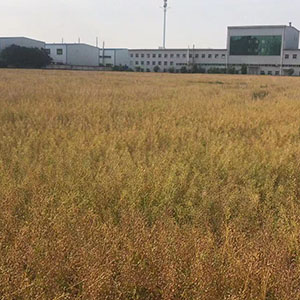Agronomic evaluation of a Chinese camelina [Camelina sativa (L.) Crantz] cultivar in multiple semi-arid locations of northern China

Accepted: 8 May 2022
Appendix: 65
HTML: 21
All claims expressed in this article are solely those of the authors and do not necessarily represent those of their affiliated organizations, or those of the publisher, the editors and the reviewers. Any product that may be evaluated in this article or claim that may be made by its manufacturer is not guaranteed or endorsed by the publisher.
Agronomic performance evaluations of spring- and fall-seeded camelina [Camelina sativa (L.) Crantz] genotypes in China are limited despite a long tradition of growing this crop in the northern parts of the country (i.e., Gansu and Xinjiang provinces). A field experiment (2015-2019) was conducted to determine the seed yield and seed quality of spring- and fall-seeded Chinese camelina cv ‘Xiaoguo’ across five locations in semi-arid regions of China. The results showed that spring- and fall-seeded camelina ‘Xiaoguo’ has highly adapted to the different growing environments in central and northern China. Location and season were the key determinants for camelina seed yield, but not the year. Across locations and years, the mean seed and oil yields for fall-seeded camelina were more significant than those of spring-seeded camelina (seed yield: 2115 vs 1751 kg ha–1; oil yield: 672 vs 547 kg ha–1). Fall-seeded camelina at Huangzhong had the highest mean seed (2497 kg ha–1) and oil yield (784 kg ha–1), followed by fall-seeded in Anyang (2219 and 714 kg ha–1), compared to other locations (range of mean: 1566-2033 and 489-639 kg ha–1). The contents of saturated, monounsaturated, and polyunsaturated fatty acids in camelina seed oil varied from 11-14% (mean: 12%), 31- 34% (mean: 32%), and 54-57% (mean: 56%), respectively. The mean β-sitosterol and total flavonoid contents across locations and years were 1723 μg g–1 (range: 1680-1778 μg g–1) and 3.4 mg g–1 (range: 2.7-3.8 mg g–1), respectively. In summary, its extensive environmental adaptability to drought and low temperature indicates that camelina is well-suited as an alternative oilseed crop or dual cropped with other crops in central and northern China or other countries with similar agricultural conditions. Camelina also showed great potential as a source of bioactive compounds (i.e., flavonoids, β-sitosterol) for pharmaceutical applications.
Highlights
- Agronomic performance of spring- and fall-seeded camelina cv ‘Xiaoguo’ was evaluated in semi-arid regions of China.
- Camelina cv ‘Xiaoguo’ showed good adaptability to the different growing environments in central and northern China.
- Spring camelina seedling transplanting provides an alternative approach to increase yield.
- Bioactive compounds (i.e., flavonoids, β-sitosterol) were detected in camelina seed.
- Camelina is promising as edible oil, biodiesel, and pharmaceutical source in semi-arid regions of China.
How to Cite

This work is licensed under a Creative Commons Attribution-NonCommercial 4.0 International License.
PAGEPress has chosen to apply the Creative Commons Attribution NonCommercial 4.0 International License (CC BY-NC 4.0) to all manuscripts to be published.

 https://doi.org/10.4081/ija.2022.2034
https://doi.org/10.4081/ija.2022.2034



